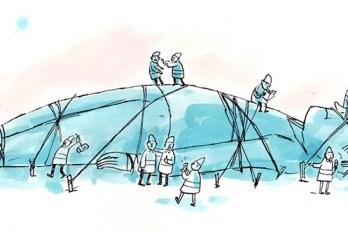Last December, I witnessed a small miracle. Cancer had relegated my father to a bed in a darkened room where only his closest friends and family came to visit. On this day, he was surrounded by my mother, my sisters, and me, as well as James Weisgerber, the Archbishop of Winnipeg.
There was a long time when a man of the cloth would not have been welcome in my dad’s home. He attended a Catholic-run Indian residential school as a child and was angry for many years after. He was one of the more than 150,000 First Nations, Inuit, and Metis children taken away from their families. He lived through all of the horror stories you’ve heard, and his school was among those recently revealed by historian Ian Mosby to have conducted nutritional experiments on children, in which vitamin and mineral supplements were manipulated, causing anemia among many of them. My father was likely part of these experiments. He was badly scarred from the attempt to “kill the Indian in the child,” and he spent decades sorting through the trauma.
In time, he found personal salvation through the traditional Sun Dance ceremony. Still, he yearned for reconciliation, with the Church, but internally as well. He needed to bridge the competing forces Catholicism had spawned within him. The Church was responsible for so many of his inner demons, but his years in residential school had also indelibly imprinted his relationship with God.
My father was in the House of Commons on June 11, 2008, to hear Stephen Harper apologize to the survivors of residential schools, the first formal apology from a prime minister for the federally funded program. That era caused so much pain for so many that no apology will ever be enough for all who were affected. And many people, myself included, wonder how sincere the apology was: the government, for instance, has yet to turn over all relevant documents to the Truth and Reconciliation Commission of Canada.
For my father, however, the apology helped him continue his healing journey. The following year, he travelled to the Vatican to hear Pope Benedict XVI express his sorrow over residential schools. Around this time, my dad befriended Weisgerber and persuaded him to participate in the Sun Dance. Eventually, my dad adopted the archbishop as his brother in a public ceremony. In our tradition, an adoption is all about peacemaking, where we commit to a rapprochement by forging the unbreakable bond of kinship.
In October 2012, my father returned to the Vatican, for the canonization of Kateri Tekakwitha, the first Indigenous saint from North America. Seeing “our little sister” raised to such heights put a huge grin on his face, though he was already very ill.
Which brings me back to that day last December. My father’s strength had left him, his breathing was haunted by a wheeze, and he was no longer speaking. There would be no recovery. The archbishop prayed for my dad, then said to him, “Pray for me, too.” The tone in Weisgerber’s voice told me he did not expect my father to oblige. Yet as the archbishop stood to leave, my dad reached out to grasp his hand. I looked on in shock as my dad spoke, eyes closed: “Aho kaa’anishinaa nimishomis, kizhawaynimin…”
After praying, my father relaxed, his eyes still closed. I had seen an apology. Now I had also seen forgiveness.



